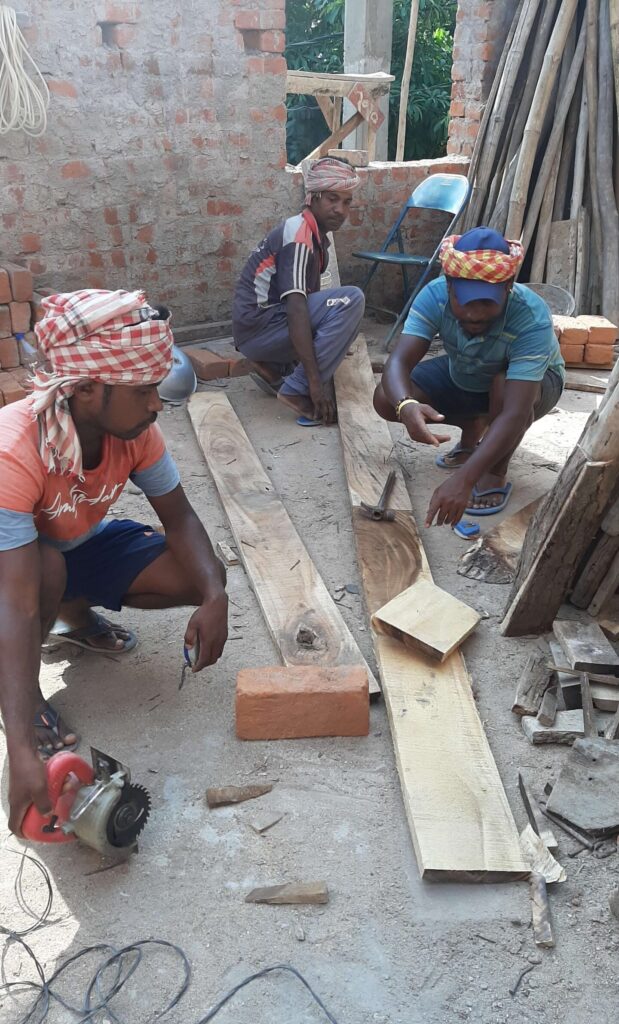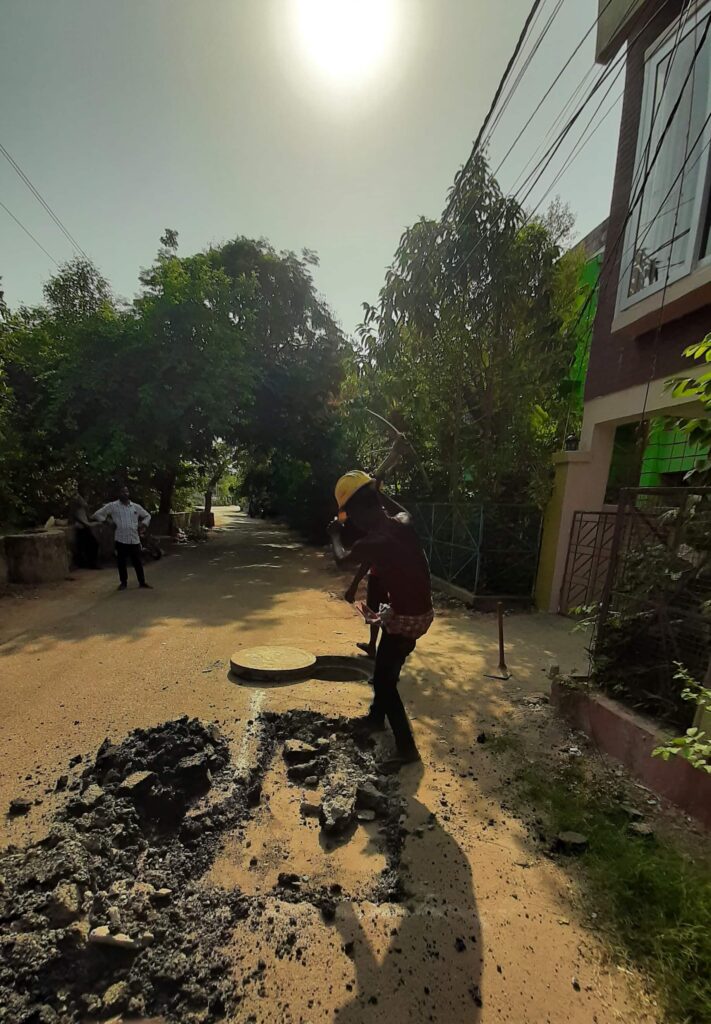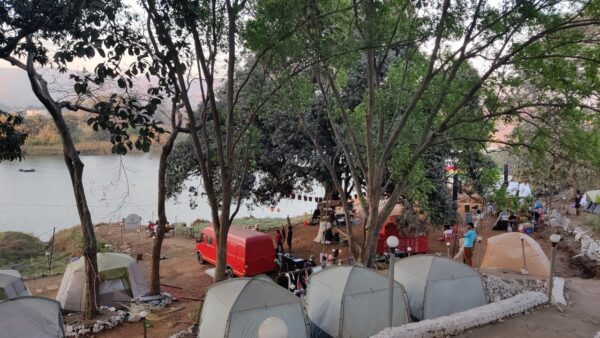A few metres away from the iconic sculpture and turnaround at Master Canteen Square (in the picture above) in Odisha’s capital Bhubaneswar, a public announcement system blares away these days. Situated at a traffic junction, it continuously hands out advice to beat the sweltering heat in the city in the form of dos and don’ts: Do not venture out between 11am and 3.30pm, cover your head with a cloth when outdoors, keep drinking water, and so on.
These might seem banal instructions but they matter a great deal during heat waves of the sort that Bhubaneswar has been experiencing this summer. In April itself, the day temperatures were in the mid-40s and crossed 43 degrees Celsius on April 24. The city’s toll-free COVID helpline, relatively silent after the pandemic subsided, was reactivated to receive heat-related complaints and offer consultation or advice to those who dialled in.
Reeling under intense heat, Odisha announced shutting schools for five days in April. Just as rainy day and cyclone day holidays have become the norm in the state, heat wave holidays are becoming the new normal. Odisha, which has been lauded for its disaster management during cyclones, faces another climate challenge: Heat.
The warnings are loud and clear. The cyclone-prone state has the classical urban heat islands. Twelve districts in Odisha had recorded a significant rise in the trend of severe heat wave events from 1951 to 2016. This was cited in a study, ‘Changing Spatio-temporal trends of a heatwave and severe heatwave events over India: An emerging health hazard’, which was released last year.
Bhubaneswar exemplifies the trend. This year’s summer temperatures were in the 40s. In March last year, the city recorded 44.2 degrees Celsius for the first time in 73 years. Its maximum temperature crossed 40 degrees Celsius in February last year – for the first time after 58 years.
Combined with its characteristic humidity, the heat makes it unbearable for most people to get through the summer days; poorer people without access to adequate cooling measures and informal workers who are forced to be outdoors during the high heat hours are among the worst affected.
Bhubaneswar joins a list of cities such as Chennai, Mumbai, Indore, and Ahmedabad which are at risk of reaching wet-bulb temperatures (a metric of humidity) of 32-34 degrees Celsius with continued emissions, according to the Intergovernmental Panel on Climate Change (IPCC) in its Sixth Assessment Report (AR6). Overall, Assam, Meghalaya, Tripura, West Bengal, Bihar, Jharkhand, Odisha, Chhattisgarh, Uttar Pradesh, Haryana and Punjab will be the most severely affected states in India.
“This year, rainfall activity stopped in Odisha, which is not normal. The deficit was 96 per cent, leading to a rise in temperature,” says Uma Shankar Das, a scientist at the India Meteorological Department’s (IMD) regional office in Bhubaneswar.
In the face of punishing heat and recurring heat waves, it has become imperative to review and expand the Heat Action Plan (HAP). Climate Crisis is staring in our faces. Given the emergency nature of the heat waves, the implementation and actionability of the HAP has to be on a war footing.
What went wrong
Bhubaneswar, among India’s first planned cities, was a cool haven with green open areas, parks and wide roads, forest patches abutting it and a pleasant climate. The Kuakhai, a distributary of the Mahanadi, and Daya rivers flowed nearby.
When German architect Otto Koenigsberger designed Bhubaneswar in 1948, it was planned for 40,000 people. The city’s population has increased to more than 1.2 million now. In the process of expansion and ‘development’ which added built-up areas to the city, the surrounding open and green zones – the city’s lungs or natural air coolers to combat heat – have shrunk or disappeared. Concrete jungles have mushroomed haphazardly, damaging the natural eco-system which the city once boasted of. Bhubaneswar hardly reflects the attention to micro details of town planning with neighbourhood units, city centre, and tree cover of the city’s original master plan.
“The city has expanded drastically and beyond its capacity. Urban planning is being done following an outdated model. Almost every year, urban areas are expanding, and agricultural fields are shrinking. Most of the marshy lands have disappeared. Buffer zones such as the Chandaka Forest and fringe areas too have been damaged by concretisation,” says urban planner Piyush Rout, who has seen the cycle-friendly town transform into a car-loving city. Recent satellite images of Bhubaneswar, he says, show green spaces but these are hardly useful as ornamental trees have been planted after axing big native trees.
“…significant changes in utilising land use and land cover through over-exploitation of natural resources and the related spatio-temporal variations in land surface temperatures has been identified as one major factor responsible for changes in the Urban Heat Island effect over Bhubaneswar,” states a research paper ‘Impact of Rapid Urbanization on the City of Bhubaneswar, India’ presented in 2017.
How significant is the change? “Owing to rapid urbanisation (83 per cent increase in 15 years), the city has undergone major changes in land use and land cover aggregating to a massive nearly 89 per cent decrease in dense vegetation and nearly 83 per cent decrease in crop fields over this time period,” notes the study abstract. It is well known that such large denudation of green cover and open areas takes away the capacity of the region to re-emit the sun’s harsh rays, instead the concrete and asphalt used in construction absorb and retain the heat.
It is no wonder that Bhubaneswar warms up with high temperatures. The city’s summer months have increased but the winter is short; and rains lead to waterlogging in parts of the city.

Photo: Shobha Surin
Bearing the brunt
Daily wage labourers and workers in the informal sector are among the hardest hit by the extreme weather event, including the heat waves now. Back at work after the slowdown due to COVID restrictions, they cannot afford to take a day – or even the harsh afternoon hours – off.
Satyananda Pradhan, 46, is busy at his sugarcane crusher on the road opposite XIM University. A juice seller for 15 years here, he has not seen such a harsh summer ever. “It is exhausting to be outdoors the entire day. I take only an hour off for lunch,” says Pradhan, who keeps his stall open till 10pm. He had expected to make good the COVID losses this year but customers have dwindled. “Not many people come in the scorching heat,” he says.
Women labourers at construction sites are badly hit. The government’s restrictions for heat disallow physical outdoor work from 11am to 3.30pm. This also means they start early in the morning and must finish household chores before they reach construction sites, but they feel heat-related fatigue.
“It is difficult doing manual work in this weather. We run out of drinking water in a few minutes,” says Romila Mallik, 35, working in Nayapalli. Rita Pradhan, 33, carries gravel and dumps it where others are mixing cement. “This year, the heat is unbearable. We take breaks to rest and drink water. I fear falling ill…I will lose my wage,” she says.
Madan Badaik, 32, Abhiram Kullu, 31, and Sanjay Lakra, 30, are a month behind the deadline to build a three-room private house at Maitri Vihar. “It is impossible to work during the day. We work from 5am to 10am and from 3.30pm to 6pm. This has slowed down our work and doubled the time to complete it,” says Badaik. They are from Sundergarh district in northwest Odisha, which recorded temperatures above 41 degrees Celsius. “We come from a place which sees many heat waves. We take precautions…drink water and always keep our head covered,” says Kullu.
A water bottle and glucose powder packet are constant in Sushant Kumar Nayak’s, 34, bag. A food delivery agent for three years, Nayak, fully clothed from head to toe to stave off the sun’s rays, says: “I get exhausted but I have to work.”
Contract labourers employed by the Bhubaneswar Municipal Corporation are carrying out pre-monsoon work of cleaning drains and sewage lines. “This year’s summer is scalding hot,” says Sentu Shaikh, 35, who is supervising the work. “The BMC has given us glucose packets so that we don’t suffer a heat stroke.” The workers take breaks every half hour exemplifying what researchers have been warning: Extreme weather, an ecological phenomenon, will dent economic productivity across the globe.
Heat Action Plans and beyond
Even as the vulnerable population sweats it out, clear and comprehensive steps to tackle the most devastating impact of Climate Change are needed which go beyond the immediate counter measures listed in Heat Action Plans.
“It has been more than 20 years we have been preparing and modifying plans to combat heat. Unlike floods, individual preparedness is more important in tackling heat wave. In 1998, the state saw the high heat wave casualties. We have developed a mobile app ‘Satark’ to inform and alert people about any climate event,” says Gyana Ranjan Das, executive director, Odisha State Disaster Management Authority (OSDMA).
Although Odisha is one of the cities in India to have drafted a Heat Action Plan (HAP), its implementation has been less than satisfying as it is mostly an advisory for people and does list measures for preserving green zones. The IPCC reports which underline the urgency of the situation call for the HAPs to be reviewed, strengthened and implemented at the earliest for the sake of ecology and economy.
“The Heat Action Plan has not been implemented fully. The state drafted a climate change mitigation plan around 12 years ago but it has not been implemented either. Under the Smart City Project, a lot of big trees were cut and the muddy sidewalks have been paved. The city had a three-kilometre-long lake but the water body has been entirely encroached upon,” says environmentalist Biswajit Mohanty.
Mohanty has touched upon a point that will be crucial in the years to come as Bhubaneswar expands further. “We are heading towards more urbanisation. Concrete areas are increasing and wetlands are decreasing. This could further impact the rising temperature,” says Das.

Photo: Shobha Surin
While the HAPs are essential to combat heat waves and heat-related illnesses through public awareness (like the public address system near Master Canteen Square) and building protocols, they cannot address the core issue about rising temperatures: construction at the cost of natural areas or urban design itself. This calls for a change in the approach to city building itself in which natural and green areas have to be prioritised.
Designing climate-friendly and low-emission buildings will ensure they are not heat traps. “We can control some aspects through proper planning, policies and an action plan. We need a qualified group of people to chalk out policies,” says the environmentalist.
“The constitution of Bhubaneswar Regional Improvement Trust (BRIT) in 1976 and subsequently Bhubaneswar Development Authority (BDA) in 1983 came into existence and were a push to direct the planning forces in the direction of urban growth. This stage in the evolution of the city saw the rise of mass housing and organized living quarters in various areas of the city. Major housing schemes and multi-storied buildings were executed during this period. The emergence of markets near residential complexes was observed,” reads the study. [1]
The research by Ananya Nayak, an architecture student, shows how government offices began to emerge during 1956-76; several schools, industrial units, and industrial estates were established, and these areas saw a rise in people settling down. The lush green Bhubaneswar, which hardly saw a harsh summer, had begun changing to a concrete version of itself.
The city initially reflected Odisha’s economy based on forest and agricultural produce. As it took shape into a thriving city with an economy based on mines, industry, and commerce, scant attention was paid to the environment. The road from Bhubaneswar to Nandankanan Zoological Park and Botanical Garden was through endless green fields and rows of trees. Now, there are only concrete jungles.
The 1999 super cyclone caused massive destruction to the city’s ecology, uprooting most of the big trees. Subsequently, Bhubaneswar carried out plantation drives only to axe the grown trees a few years later for development projects such as road widening. “The city has lost more than 5,000 trees in the past few years. Many big native trees have been cut and exotic trees planted as replacement,” says environmentalist Mohanty.
“Bhubaneswar grew rapidly but failed to be made climate-resilient,” says SN Patra, president, Odisha Environment Society. The planned city, expanding at the cost of its ecology, has a new challenge: to adapt to the Climate Change events in ways that protect life and environment.
Shobha Surin, currently based in Bhubaneswar, is a journalist with 20 years of experience in newsrooms in Mumbai. She has seen Bhubaneswar from close quarters as the quiet green city transformed into a bustling concrete jungle. An associate editor at Question of Cities, she is concerned about Climate Change and is learning about sustainable development.
Cover photo: Shobha Surin




